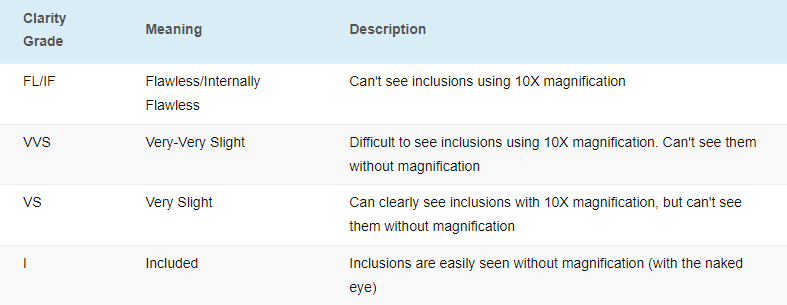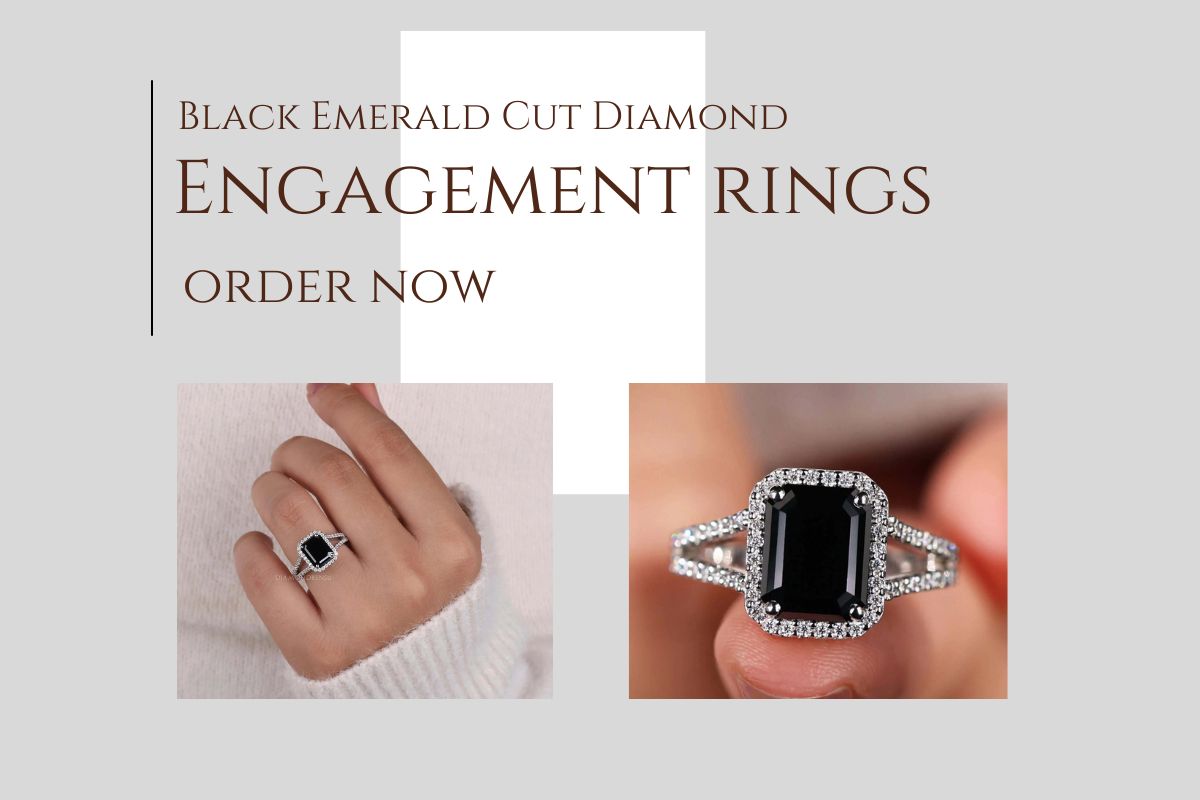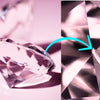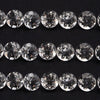
Black Spot in Diamond: Clarity Characteristics Explained
Diamonds are renowned for their exceptional hardness and brilliant sparkle, but they're also known to host a range of internal inclusions, which are natural characteristics within the stone itself. Among these, black spots are a type of inclusion resulting from imperfections in the crystallization process. Formed from crystals of carbon that didn't fully crystallize, black spots are inherent to the diamond's structure, and they vary in size and visibility.
Table Of Contents
- Overview of Diamond Inclusions
- Understanding Black Spots in Diamonds
- Clarity Grading and Black Inclusions
- Effect on Diamond Value and Integrity
- Treatment and Removal Techniques
- Choosing the Right Setting for Diamonds with Black Spots
- Maintaining and Cleaning Diamonds with Black Spots
- Consumer Guide
- Frequently Asked Questions
We understand that these black spots are a common occurrence, naturally embedded during the diamond's formation deep within the Earth. While the presence of these spots can influence the clarity and value of a diamond, it’s important to recognize them as a natural characteristic. They offer insight into the unique story of each stone's journey from the depths of the Earth to its polished final form. The nature and appearance of black spots can differ widely from one diamond to another, and their impact on a diamond's aesthetics can range from negligible to more pronounced.
As connoisseurs and enthusiasts in the jewelry world, we appreciate that diamonds are a symbol of distinction, and so we take a closer look at these black spots to assess their effect on a diamond’s overall appearance. It's crucial when selecting a diamond to consider how these natural inclusions interact with the stone’s other features, such as its cut, color, and brilliance. Our collective expertise guides us in evaluating how these characteristics coalesce to create the unique beauty of each diamond, black spots and all.
Overview of Diamond Inclusions
Feather
🪶 Small cracks or fractures inside the diamond
Crystal
💎 Mineral crystals trapped inside the diamond
Cloud
☁️ Group of tiny inclusions that give a hazy appearance
Pinpoint
📍 Very small dots, often white or black, within the diamond
Needle
🪡 Long, thin inclusions resembling needles
Knot
🔗 Crystal that reaches the diamond’s surface
Cavity
🕳️ Opening on the diamond's surface
Diamond inclusions are internal characteristics that can affect the appearance and value of the gem. Their origins lie in the diamond's formation and they vary in type and impact. Understanding inclusions is key to evaluating a diamond's quality.
Formation and Composition
Formation: Diamonds are created under intense heat and pressure deep within the Earth. These conditions can trap various elements and compounds within the carbon structure as it crystallizes, leading to the formation of inclusions.
Composition: Most inclusions are of a carbonaceous nature, as diamonds are primarily carbon. Other mineral inclusions also occur, reflecting the complex environment of diamond formation. These inclusions are natural parts of the diamond’s structure and can be unique identifiers of individual stones.
Types of Inclusions
- Crystal Inclusions: These are actual minerals or diamonds enclosed within the host diamond. The visibility and reflectiveness of these crystals can vary.
- Pinpoints: Tiny dots, usually white or black, within the diamond that might seem like dots of dust. These are often clustered together to form a cloud.
- Clouds: Hazy areas formed by many pinpoints close together, sometimes impacting the diamond's transparency.
- Feathers: These are cracks in the diamond that have the appearance of feathers. Their significance varies with size and location.
Here, the focus is on carbon flaws like black spots, which are uncrystallized carbon. They're not synthetic defects but inherent characteristics that could affect the stone's clarity.
Inclusions vs Flaws
Inclusions refer specifically to internal features, while flaws can be internal or external. The term “flaw” is often used more broadly to describe any feature that affects a diamond's perfection. The distinction is important because it impacts how a diamond is graded and valued. For instance, surface blemishes are flaws but not inclusions. In terms of inclusions, their size, location, visibility, and color can affect a diamond's overall appearance and thus, its grade. The impact of an inclusion depends on how it interacts with light, whether it’s hidden by the setting, and if it poses any risk to the diamond’s durability.
Understanding Black Spots in Diamonds

In our exploration of black spots in diamonds, we focus on their identifying characteristics and delve into the common causes behind these imperfections. By understanding these aspects, we can appreciate the uniqueness of each diamond and make informed choices when selecting gemstones.
Characteristics of Black Spots
Black spots in diamonds, often referred to as carbon spots or pepper inclusions, are small, dark inclusions visible within the diamond's structure. These inclusions are part of the natural formation of the gemstone and vary in size and quantity. When inspecting diamonds, black spots can be seen as:
- Size: Varying from microscopic to noticeable with the naked eye.
- Quantity: Ranging from solitary inclusions to numerous spots scattered throughout the stone.
- Location: Found anywhere within the diamond, including near the surface or deep within.
These characteristics significantly influence the clarity and overall appearance of the diamond.
Common Causes of Black Spots
Inclusions
🪨 Natural mineral inclusions trapped during diamond formation
Graphite
🖤 Presence of graphite, a form of carbon, within the diamond
Other Minerals
🔍 Inclusions of other dark-colored minerals
Growth Patterns
🌱 Irregular growth patterns during the diamond’s formation
Internal Fractures
⚡ Small internal fractures that appear dark
Surface Graining
📏 Surface graining can create the appearance of black spots
The primary cause behind the formation of black spots in diamonds is the presence of uncrystallized carbon during the diamond's creation. As diamonds form over billions of years under high pressure and temperature conditions, not all carbon atoms crystallize perfectly, resulting in these tiny imperfections. Here are the specifics:
- Formation Process: Black spots are natural occurrences, resulting from the diamond's growth conditions in the earth's mantle.
- Crystallization Inconsistency: These spots reflect areas where carbon did not fully transform into the crystalline diamond structure.
Understanding that black spots are not flaws that can be removed by polishing, but rather inherent characteristics of the diamond, can help us appreciate the unique story each stone tells.
Clarity Grading and Black Inclusions

When assessing diamonds, we carefully consider the presence of black inclusions as they play a critical role in determining the clarity grade. Now let's break this down into specifics:
Clarity Grade Categories
The Gemological Institute of America (GIA) has established standardized clarity grades for diamonds. Clarity is a measure that assesses the absence of inclusions and blemishes. Here is an outline of GIA's clarity grades:
- Flawless (FL): No inclusions or blemishes visible under 10x magnification.
- Internally Flawless (IF): No inclusions visible under 10x magnification.
- Very, Very Slightly Included (VVS1 and VVS2): Inclusions so slight they are difficult for a skilled grader to see under 10x magnification.
- Very Slightly Included (VS1 and VS2): Inclusions are observed with effort under 10x magnification but can be characterized as minor.
- Slightly Included (SI1 and SI2): Inclusions are noticeable under 10x magnification.
- Included (I1, I2, and I3): Inclusions are obvious under 10x magnification which may affect transparency and brilliance.
Impact of Black Spots on Grading
Black spots in diamonds, essentially small black crystals or minerals, can significantly impact a diamond's clarity grade. Their effect on the grading depends on their size, number, and location within the diamond:
- SI Clarity: Diamonds with black spots may fall into the Slightly Included category if the spots do not overly detract from the stone's beauty and are not immediately obvious without magnification.
- I Clarity: A diamond possessing black spots that are noticeable to the naked eye typically receives an I clarity grade. Within this category, grades range from I1 to I3, with I3 being heavily included.
- I2: This grade indicates a diamond where inclusions such as black spots are prominent, often affecting the stone's appearance.
- Flawless Diamonds: By definition, flawless diamonds do not contain black spots or any other inclusions.
Understanding these details helps us appreciate the nuanced impact that black inclusions have on clarity grading and the overall value of a diamond.
Effect on Diamond Value and Integrity
| Aspect | Description |
|---|---|
| Visibility | 👁️ Black spots can be visible to the naked eye, affecting appearance |
| Value | 💰 Presence of black spots lowers the overall value of the diamond |
| Clarity Grade | 📉 Reduces the clarity grade, impacting market desirability |
| Light Performance | 💡 Affects how light passes through the diamond, reducing brilliance |
| Durability | 🛡️ Generally, black spots do not impact the structural integrity |
| Cut Quality | ✂️ High-quality cuts may minimize visibility of black spots |
| Market Demand | 📈 Diamonds without black spots are more in demand and fetch higher prices |
In analyzing diamonds, particularly for engagement rings, we must consider both value and structural integrity. Black spot inclusions can affect these parameters, influencing not only the visual appeal but also the appraisal of the diamond's worth.
Appraisal of Black Spot Inclusions
When appraising diamonds, we meticulously observe the size, quantity, and placement of black spot inclusions. These imperfections are comprised of uncrystallized carbon and are intrinsic to the diamond. They cannot be removed through polishing, and their presence can diminish the stone's brilliance and fire, key factors in determining a diamond's value.
- Size: Larger spots are more detrimental to value.
- Quantity: Numerous spots can significantly reduce a diamond's appeal.
- Location: Spots closer to the center or along facets can affect light dispersion.
A diamond's integrity, however, remains largely intact as black spots do not weaken the diamond's structure.
Perception of Value and Aesthetics
Black spots influence both the perceived and actual value of a diamond. From an aesthetics standpoint, black inclusions can detract from the visual purity and sparkle that are pivotal in an engagement ring. The more noticeable the spots, the less desirable the diamond typically becomes.
- Engagement Ring Considerations:
- Visual Appeal: We look for minimal inclusions to ensure maximum light performance.
- Brilliance and Fire: These are qualities that can be compromised by prominent black spots.
In the market, diamonds with fewer or smaller black spots generally command higher prices. However, it’s worth noting that some may overlook minor spots in favor of a larger carat size or other desirable attributes. We, as professionals, weigh these factors thoroughly to determine a fair market value for each individual diamond.
Treatment and Removal Techniques

In our pursuit of perfection, we address inclusions in diamonds, particularly black spots, with advanced treatments. These efforts can improve clarity and enhance the overall appearance of the diamond.
Laser Drilling
🔬 Precisely removes black spots using a focused laser beam
Fracture Filling
🛠️ Fills internal fractures with a clear substance to hide black spots
High-Pressure High-Temperature (HPHT) Treatment
🔥 Alters the diamond's inclusions and overall appearance through extreme heat and pressure
Clarity Enhancement
✨ General treatments to improve overall clarity, making spots less visible
Re-Cutting
✂️ Removing parts of the diamond to eliminate visible black spots
Internal Laser Treatment
💡 Targets inclusions directly within the diamond to reduce visibility
Laser Drilling
Laser drilling is an established technique we use to treat black spot inclusions in diamonds. By employing a high-intensity laser beam, we create a microscopic channel to the inclusion. The intense heat can sometimes cause the dark inclusion to evaporate or shrink, rendering it less visible. It's important to note that this process is permanent and should always be disclosed to the buyer. The Gemological Institute of America (GIA) records laser-drilled diamonds as treated.
Fracture Filling
Fracture filling is another method we employ which involves injecting a glass-like resin into cracks or fractures associated with a black spot. This substance refracts light in a similar way to the diamond, making the inclusion less noticeable. However, this treatment is not as durable as laser drilling; hence, special care must be taken when cleaning or repairing fracture-filled diamonds.
The Debate on Treatment Methods
The ethicality and durability of diamond treatments, such as laser drilling and fracture filling, are subjects of debate within our community. We acknowledge the importance of transparency in these enhancements as recognized by the GIA and other gemological institutions. Buyers should always be informed about any treatments a diamond has undergone, as they can affect the stone's value, care requirements, and long-term appearance.
Choosing the Right Setting for Diamonds with Black Spots
When considering diamonds with black spots, the setting we choose plays a crucial role in either concealing or integrating these inclusions.
Role of the Setting in Masking Inclusions
The setting of a diamond is not merely for aesthetic appeal; it serves a functional purpose in enhancing the stone's appearance and masking inclusions. Prongs are particularly useful for this task. Strategically placed prongs can cover black spots, especially those situated around the edges of the diamond. Moreover, the cut and polish of the diamond can be aligned with the setting to divert attention from black spots. It's essential to work with skilled jewelers who understand how to optimize these elements for the best visual impact.
Types of Settings Suitable for Black Spot Inclusions
Certain types of settings are better suited for diamonds with black spot inclusions:
- Bezel Setting: Encloses the rim of the diamond, which not only protects the stone but can also hide inclusions near the diamond's edge.
- Prong Setting: Allows light to enter the diamond but can also strategically cover spots when positioned over them.
When selecting a setting, consider consulting with established vendors like James Allen, who provide high-resolution images and may offer advice on suitable settings for your particular diamond. Additionally, certifications from entities like the Gemological Institute of America (GIA) can inform us of the inclusion's characteristics and help us decide how best to complement the diamond through precise mounting.
Maintaining and Cleaning Diamonds with Black Spots

When tackling the maintenance of diamonds with black spots, our focus is on preserving their visual appeal. The presence of black spots can challenge the stone's brilliance, but with proper care and regular maintenance, we can ensure that our diamond's luster remains as vibrant as possible.
Routine Cleaning Advice
For Routine Cleaning, start with a simple solution:
-
Prepare a Cleaning Solution
- Mix warm water with a few drops of mild dish soap.
-
Soak the Diamond
- Place your diamond in the solution and let it soak for 20-40 minutes.
-
Gently Scrub
- Use a soft-bristled toothbrush to carefully remove any lingering residue.
-
Rinse and Dry
- Rinse the diamond with warm water and pat dry with a lint-free cloth.
Note: We recommend performing this cleaning process every two weeks to maintain the diamond's sparkle and prevent build-up that can mask black spots and impact the gem's overall appearance.
Professional Maintenance Recommendations
For Professional Maintenance, we consider the guidance of the Gemological Institute of America (GIA):
- Regular Inspections: Have your diamond inspected annually by a professional. They can ascertain if the black spots have any influence on the structural integrity of the diamond.
- Expert Cleaning: Professional jewelers have specialized equipment, such as ultrasonic cleaners, that can provide a deeper clean without damaging the stone.
- Grading and Advice: A professional gemologist can grade your diamond and offer personalized advice on maintaining a diamond with black spots, tailored to its unique characteristics.
By adhering to these meticulous maintenance steps and seeking knowledgeable professional advice, we ensure that our diamond retains its beauty, regardless of inherent flaws like black spots.
Consumer Guide
In this section, we'll help you navigate the intricacies of diamond clarity and provide insights on diamond certification. Understanding these areas is crucial for making informed decisions and ensuring you select a diamond that meets your standards.
Evaluating Diamond Clarity Prior to Purchase
When assessing diamonds, clarity is a prime factor that affects value. Clarity refers to the presence of inclusions such as black spots, and is graded by how visible these imperfections are under magnification. Here's a quick guide to clarity grades:
- Flawless (FL): No inclusions or blemishes visible under 10x magnification.
- Internally Flawless (IF): No inclusions visible under 10x magnification.
- Very, Very Slightly Included (VVS1 and VVS2): Inclusions so slight that they are difficult for a skilled grader to see under 10x magnification.
- Very Slightly Included (VS1 and VS2): Inclusions are observed with effort under 10x magnification, but can be characterized as minor.
- Slightly Included (SI1 and SI2): Inclusions are noticeable under 10x magnification.
- Included (I1, I2, and I3): Inclusions are obvious under 10x magnification which may affect transparency and brilliance.
Before purchasing, always review the diamond under magnification. Black spots can be an eye sore, reducing the stone's aesthetic appeal, especially if they are visible to the naked eye. The diamond's clarity grade should align with the clarity you observe.
Understanding the Diamond Certification

Obtaining a diamond certification from a reputable lab, such as the Gemological Institute of America (GIA), is indispensable. The certificate provides an unbiased analysis of the diamond’s attributes, including its clarity grade. Here's what you should look for:
- Certification Body: Ensure the diamond is certified by a recognized institution like the GIA.
- Clarity Grade: Check the provided clarity grade, acknowledging that higher grades typically mean fewer visible inclusions.
- Carat Weight: Heavier diamonds often harbor more inclusions. The carat weight can influence the impact of these inclusions on the diamond's overall appearance.
Remember, a certificate is a blueprint of your diamond's quality. We recommend studying the certification carefully to fully understand the implications of the diamond's clarity on its beauty and value.
Also Read
Frequently Asked Questions
In this section, we've compiled some of the most common inquiries about diamonds with black inclusions, offering clear, authoritative answers to assist with your understanding.
Are diamonds with inclusions less valuable?
Yes, typically diamonds with inclusions, such as black spots, are considered less valuable. The clarity grade, which accounts for inclusions, is a significant factor in determining a diamond's value.
Can inclusions be removed from a diamond?
No, inclusions are internal characteristics of the diamond and cannot be completely removed. Some surface blemishes may be polished away, but this is not the case with internal inclusions.
What does it mean if a diamond has a black inclusion?
A black inclusion in a diamond means there is a spot of carbon that has not crystallized properly. It's a natural flaw within the stone's structure and is not the result of any artificial tampering.
Is it a common occurrence for diamonds to have black inclusions?
Yes, it's quite common for diamonds to have black inclusions. These are naturally occurring and are simply a result of the diamond formation process.
What are black inclusions in my diamond ring?
Black inclusions in your diamond ring are spots of crystallized carbon that didn't transform perfectly and remained opaque, appearing as black spots within the gemstone.
Why do some diamonds appear to have black areas?
Some diamonds appear to have black areas due to the presence of black inclusions or spots. These are small, crystallized carbon pieces that didn't fully crystallize, creating visible black flaws inside the diamond.
Checkout some of our top collections:
Leave a comment
Please note, comments must be approved before they are published.










